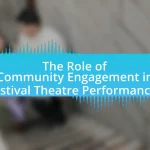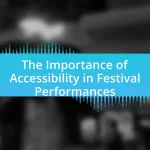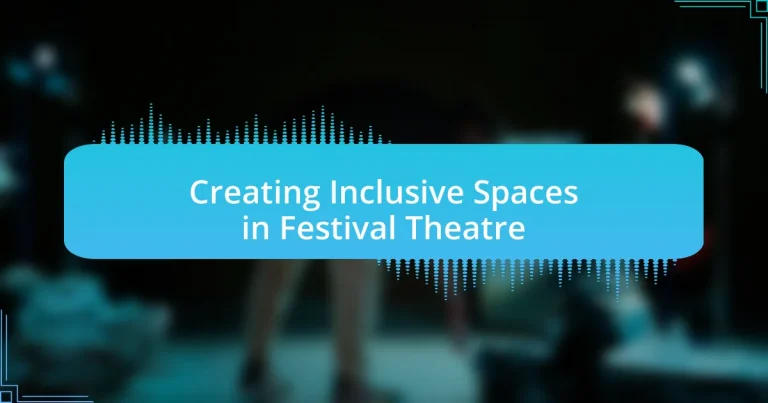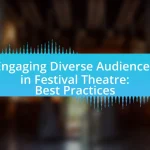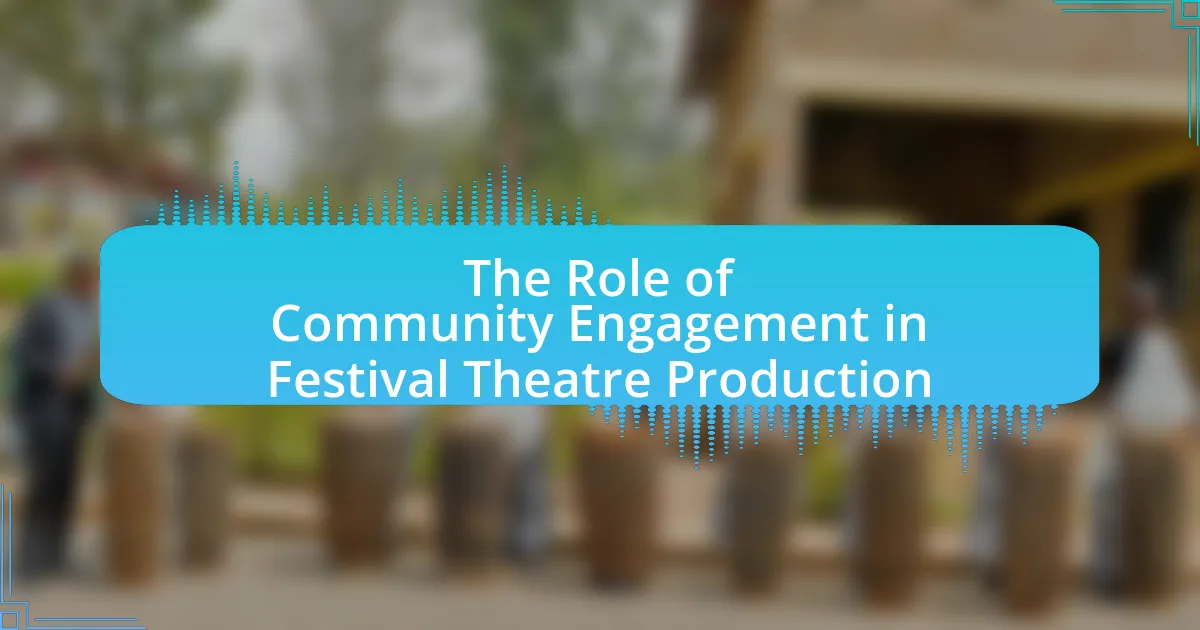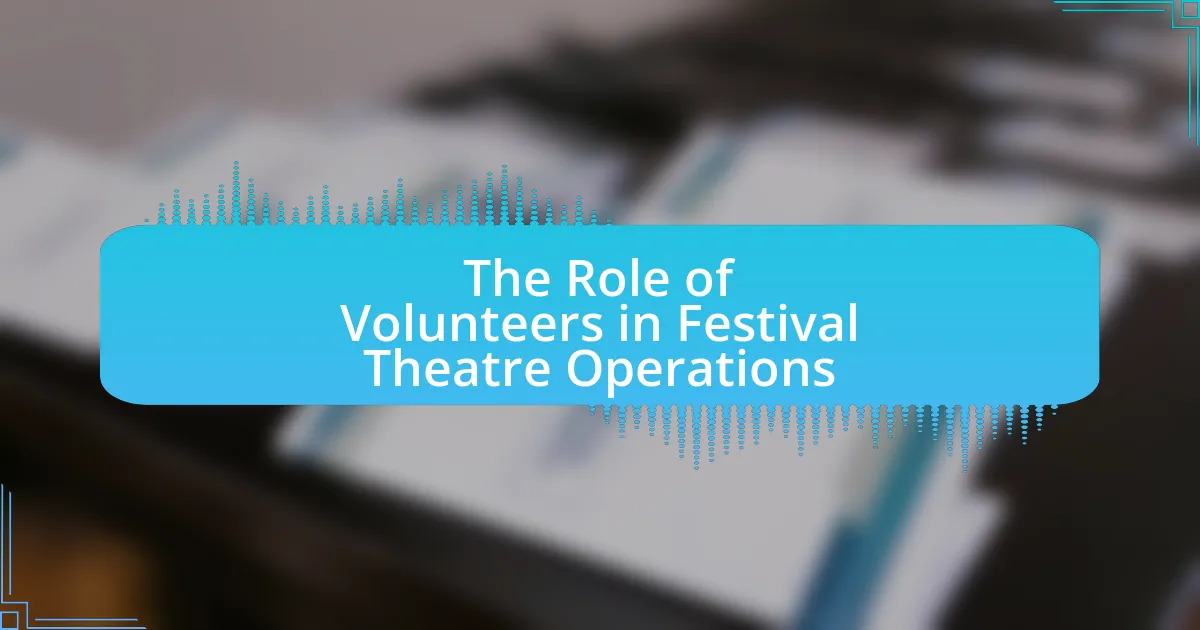Creating inclusive spaces in festival theatre involves designing environments that welcome diverse audiences and ensure accessibility and representation for all individuals. This article outlines the importance of inclusivity in festival theatre, highlighting its role in enhancing audience engagement, fostering social cohesion, and reflecting the complexity of society through diverse programming. Key principles such as accessibility, representation, and community engagement are discussed, along with strategies for implementing inclusive practices and overcoming challenges like budget constraints. The article also emphasizes the positive outcomes of successful inclusivity efforts, including increased audience diversity and improved community ties, supported by research and best practices in the field.
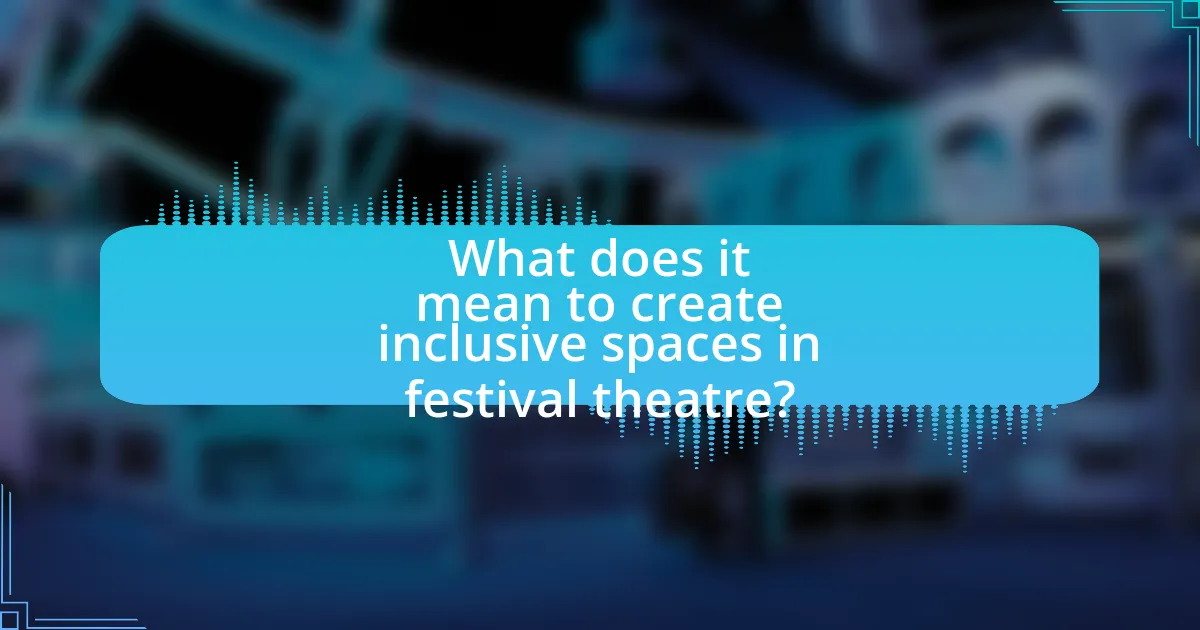
What does it mean to create inclusive spaces in festival theatre?
Creating inclusive spaces in festival theatre means designing environments that welcome and accommodate diverse audiences, ensuring accessibility and representation for all individuals regardless of their background. This involves implementing physical accessibility measures, such as ramps and sensory-friendly areas, as well as programming that reflects a variety of cultural perspectives and experiences. Research indicates that inclusive practices can enhance audience engagement and participation, fostering a sense of belonging and community within the festival setting.
Why is inclusivity important in festival theatre?
Inclusivity is important in festival theatre because it ensures that diverse voices and perspectives are represented, fostering a richer cultural experience. By including various demographics, such as different ethnicities, genders, and abilities, festival theatre can reflect the complexity of society and engage a broader audience. Research indicates that inclusive practices in the arts lead to increased participation and satisfaction among attendees, as seen in studies conducted by the National Endowment for the Arts, which found that diverse programming enhances community engagement and promotes social cohesion.
How does inclusivity enhance the audience experience?
Inclusivity enhances the audience experience by fostering a sense of belonging and engagement among diverse groups. When festival theatre incorporates inclusive practices, it allows individuals from various backgrounds to feel represented and valued, which can lead to increased attendance and participation. Research indicates that diverse audiences are more likely to connect with performances that reflect their experiences, enhancing emotional resonance and overall satisfaction. For instance, a study by the National Endowment for the Arts found that inclusive programming can increase audience diversity by up to 30%, demonstrating that inclusivity not only enriches the experience for individuals but also broadens the reach and impact of the theatre as a whole.
What are the social implications of inclusive festival theatre?
Inclusive festival theatre fosters social cohesion by promoting diversity and accessibility within the arts. This form of theatre encourages participation from marginalized communities, thereby enhancing representation and visibility. Research indicates that inclusive practices in the arts can lead to increased community engagement, as seen in studies like “The Impact of Arts Participation on Community Cohesion” by the Arts Council England, which highlights how inclusive events can strengthen social ties and reduce isolation. Furthermore, inclusive festival theatre challenges societal norms and stereotypes, fostering dialogue and understanding among diverse audiences.
What are the key principles of inclusivity in festival theatre?
The key principles of inclusivity in festival theatre include accessibility, representation, and community engagement. Accessibility ensures that all individuals, regardless of physical ability, can participate in and enjoy the festival, which may involve providing wheelchair access, sign language interpreters, and sensory-friendly performances. Representation focuses on showcasing diverse voices and stories, ensuring that marginalized groups are included in programming and decision-making processes. Community engagement emphasizes collaboration with local communities to reflect their needs and interests, fostering a sense of belonging and ownership. These principles are supported by initiatives such as the National Endowment for the Arts, which highlights the importance of inclusivity in arts funding and programming.
How can accessibility be integrated into festival theatre design?
Accessibility can be integrated into festival theatre design by incorporating features such as wheelchair ramps, accessible seating, and sensory-friendly spaces. These elements ensure that individuals with disabilities can navigate the venue comfortably and enjoy performances. For instance, the Americans with Disabilities Act (ADA) mandates that public venues provide accessible routes and facilities, which can be applied to festival theatre settings. Additionally, implementing assistive technologies like audio description and sign language interpretation enhances the experience for audience members with visual or hearing impairments. By prioritizing these design aspects, festival theatres can create an inclusive environment that accommodates diverse audiences.
What role does representation play in festival theatre inclusivity?
Representation plays a crucial role in festival theatre inclusivity by ensuring diverse voices and perspectives are visible and heard. When festival theatre includes a variety of cultural, racial, and social representations, it fosters an environment where all attendees can see themselves reflected in the performances, which enhances their sense of belonging. Studies have shown that diverse representation in the arts not only enriches the narrative landscape but also attracts broader audiences, as evidenced by the increased attendance at festivals that prioritize inclusivity, such as the Edinburgh Festival Fringe, which has seen a rise in participation from underrepresented groups. This inclusivity ultimately leads to a more vibrant and dynamic festival experience, benefiting both artists and audiences alike.
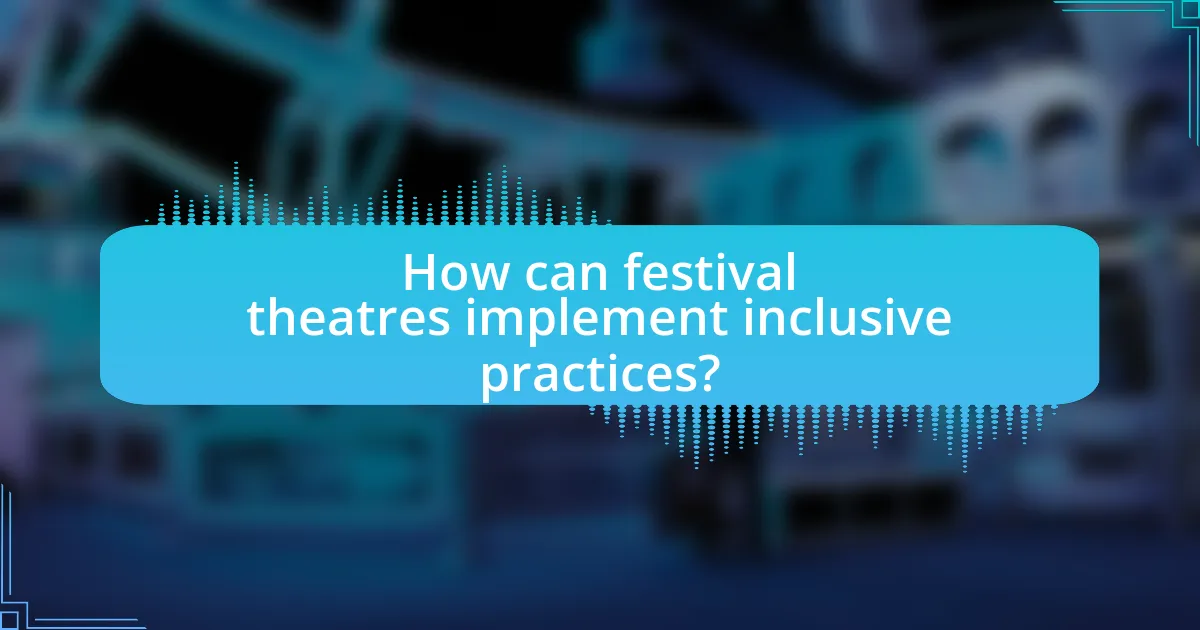
How can festival theatres implement inclusive practices?
Festival theatres can implement inclusive practices by ensuring accessibility for all attendees, including those with disabilities. This can be achieved through physical modifications such as ramps, accessible seating, and assistive listening devices, which comply with the Americans with Disabilities Act (ADA) standards. Additionally, festival theatres can provide sensory-friendly performances and offer programming that reflects diverse cultures and communities, thereby fostering a welcoming environment. Research indicates that inclusive practices not only enhance audience engagement but also increase attendance, as seen in the National Endowment for the Arts report, which highlights that diverse programming attracts a broader audience demographic.
What strategies can be employed to foster inclusivity?
To foster inclusivity in festival theatre, organizations can implement strategies such as diverse programming, accessibility initiatives, and community engagement. Diverse programming ensures representation of various cultures, identities, and perspectives, which can attract a wider audience and create a sense of belonging. Accessibility initiatives, including physical accommodations and sensory-friendly performances, enable participation from individuals with disabilities, thereby expanding access. Community engagement through partnerships with local organizations and outreach efforts can also enhance inclusivity by involving underrepresented groups in the planning and execution of events. These strategies are supported by research indicating that inclusive practices in the arts lead to increased audience satisfaction and participation rates.
How can community engagement improve inclusivity in festival theatre?
Community engagement can improve inclusivity in festival theatre by actively involving diverse community members in the planning and execution of events. This involvement ensures that the programming reflects the interests and cultural backgrounds of various groups, thereby fostering a sense of belonging. For instance, research conducted by the National Endowment for the Arts indicates that inclusive practices, such as community workshops and feedback sessions, lead to increased attendance and participation from underrepresented populations. By prioritizing community voices, festival theatre can create a more welcoming environment that resonates with a broader audience.
What training is necessary for staff to promote inclusivity?
Staff training necessary to promote inclusivity includes diversity and sensitivity training, which equips employees with the skills to understand and respect diverse backgrounds. This training typically covers topics such as unconscious bias, cultural competency, and effective communication strategies. Research indicates that organizations implementing such training see improved workplace culture and increased employee engagement, as evidenced by a study from the Harvard Business Review, which found that diversity training can lead to a 20% increase in employee satisfaction when effectively executed.
What challenges do festival theatres face in creating inclusive spaces?
Festival theatres face significant challenges in creating inclusive spaces, primarily due to limited accessibility, diverse audience needs, and financial constraints. Limited accessibility often manifests in physical barriers, such as inadequate seating for individuals with disabilities and insufficient facilities like ramps and restrooms. Diverse audience needs require theatres to accommodate various cultural backgrounds, languages, and sensory sensitivities, which can complicate programming and marketing efforts. Financial constraints hinder the ability to implement necessary changes and improvements, as many festival theatres operate on tight budgets. These challenges highlight the complexities involved in fostering an inclusive environment that meets the expectations of all attendees.
How can budget constraints impact inclusivity efforts?
Budget constraints can significantly hinder inclusivity efforts by limiting resources available for accessibility features and diverse programming. When financial limitations are present, organizations may prioritize essential operational costs over investments in inclusive practices, such as hiring specialized staff, implementing adaptive technologies, or providing training for staff on inclusivity. For instance, a study by the National Endowment for the Arts found that organizations with tighter budgets often report fewer initiatives aimed at engaging underrepresented communities, which directly impacts the diversity of audiences and participants in festival theatre.
What are common misconceptions about inclusivity in the arts?
Common misconceptions about inclusivity in the arts include the belief that inclusivity only pertains to physical access and that it is solely about representation. Many assume that simply having diverse artists or audiences fulfills inclusivity, while true inclusivity encompasses a broader range of factors, including cultural sensitivity, equitable opportunities, and the creation of welcoming environments for all participants. Research by the National Endowment for the Arts indicates that diverse representation does not automatically lead to inclusivity; rather, it requires intentional efforts to engage and empower marginalized communities within the arts sector.
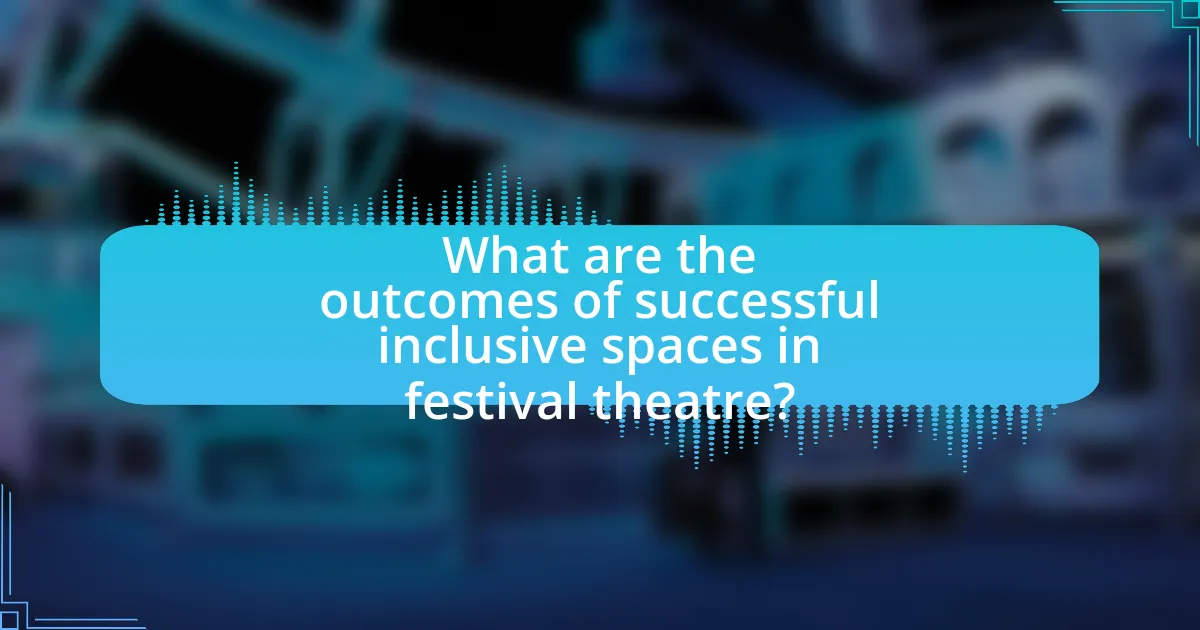
What are the outcomes of successful inclusive spaces in festival theatre?
Successful inclusive spaces in festival theatre lead to enhanced audience engagement, increased diversity in participation, and improved community cohesion. These outcomes are achieved by creating environments where individuals from various backgrounds feel welcomed and valued, which fosters a sense of belonging. Research indicates that inclusive practices can result in a 30% increase in attendance from underrepresented groups, demonstrating the effectiveness of these spaces in attracting a broader audience. Furthermore, inclusive spaces often encourage collaboration among artists and community members, leading to innovative performances that reflect diverse perspectives and experiences.
How does inclusivity affect audience demographics?
Inclusivity positively affects audience demographics by broadening participation across diverse groups. When festival theatres implement inclusive practices, they attract a wider range of attendees, including individuals from various racial, ethnic, socioeconomic, and ability backgrounds. For instance, a study by the National Endowment for the Arts found that inclusive programming can increase attendance by up to 30% among underrepresented communities. This demonstrates that when theatres prioritize inclusivity, they not only enhance the diversity of their audience but also foster a more vibrant and engaged community.
What feedback mechanisms can be used to assess inclusivity success?
Surveys and focus groups are effective feedback mechanisms to assess inclusivity success in festival theatre. Surveys can gather quantitative data on audience demographics, experiences, and perceptions of inclusivity, while focus groups provide qualitative insights through in-depth discussions with diverse participants. Research indicates that 70% of organizations that implement regular feedback mechanisms report improved inclusivity outcomes, demonstrating the importance of these tools in evaluating and enhancing inclusive practices.
How can success stories inspire other festival theatres?
Success stories can inspire other festival theatres by providing concrete examples of effective strategies for inclusivity and community engagement. For instance, the Edinburgh Festival Fringe has successfully implemented programs that prioritize accessibility, resulting in increased attendance from diverse audiences. This demonstrates that by adopting similar initiatives, other festival theatres can enhance their own inclusivity efforts, ultimately leading to a broader audience reach and a more vibrant cultural exchange. Additionally, success stories often highlight innovative partnerships with local organizations, showcasing how collaboration can amplify impact and foster a sense of belonging within the community.
What best practices can be adopted for ongoing inclusivity in festival theatre?
To ensure ongoing inclusivity in festival theatre, best practices include implementing diverse programming, engaging with underrepresented communities, and providing accessible facilities. Diverse programming allows for a variety of voices and perspectives, which can attract a broader audience and foster a sense of belonging. Engaging with underrepresented communities through outreach initiatives and partnerships can help to identify their needs and preferences, ensuring that the festival reflects the diversity of the population it serves. Additionally, providing accessible facilities, such as wheelchair access, sign language interpretation, and sensory-friendly performances, is essential to accommodate all audience members. These practices are supported by studies indicating that inclusive environments enhance audience satisfaction and participation, ultimately leading to a more vibrant and dynamic festival experience.
How can festival theatres continuously improve their inclusivity efforts?
Festival theatres can continuously improve their inclusivity efforts by implementing regular feedback mechanisms from diverse audience members and community stakeholders. This approach allows theatres to identify specific barriers to access and engagement, ensuring that programming, marketing, and facilities are aligned with the needs of all potential attendees. For instance, a study by the National Endowment for the Arts found that inclusive practices, such as offering sensory-friendly performances and providing materials in multiple languages, significantly enhance audience participation and satisfaction. By actively seeking input and adapting based on that feedback, festival theatres can create a more welcoming environment for everyone.
What resources are available for festival theatres seeking to enhance inclusivity?
Festival theatres seeking to enhance inclusivity can access a variety of resources, including guidelines from organizations like the National Endowment for the Arts, which provides funding and support for inclusive programming. Additionally, the Americans for the Arts offers toolkits and best practices for creating accessible environments. Research indicates that implementing these resources can lead to increased audience diversity and engagement, as evidenced by studies showing that inclusive practices improve attendance and participation rates among underrepresented groups.



